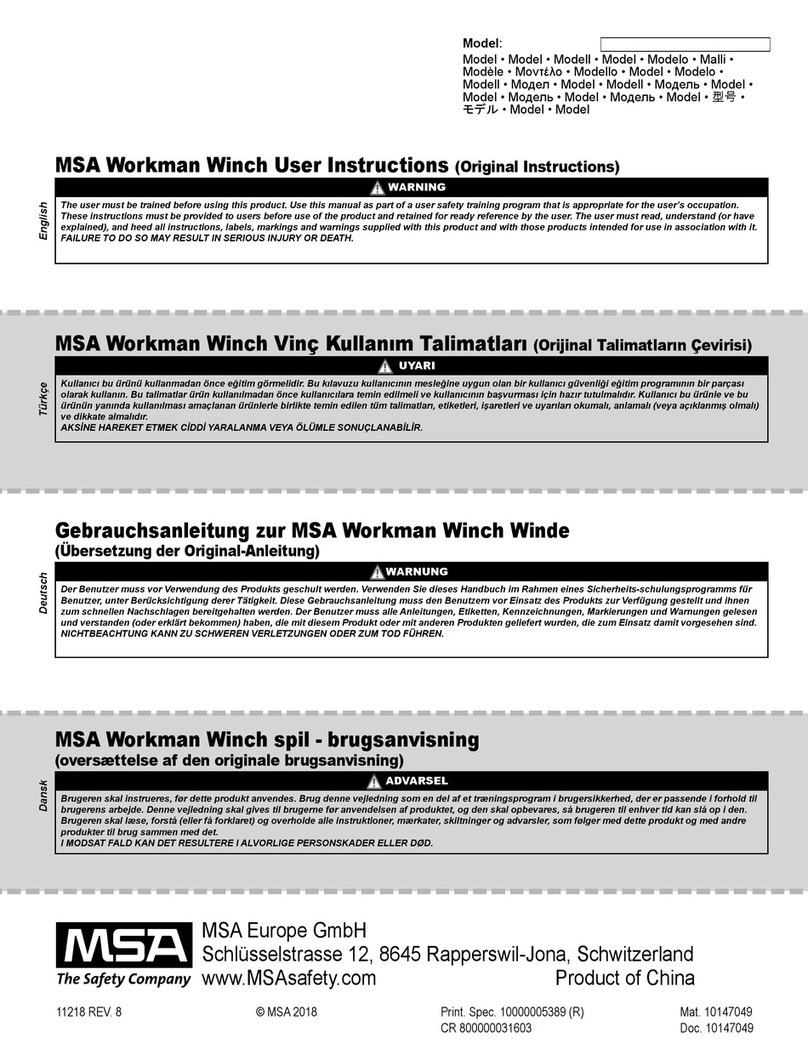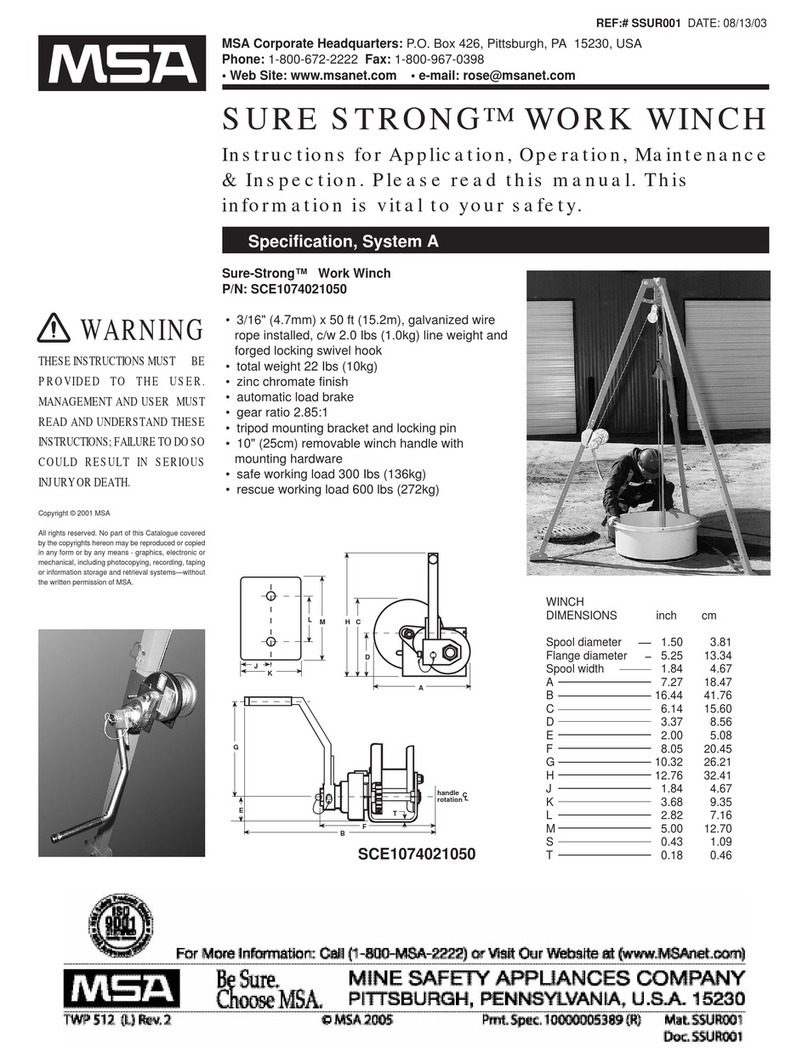
P/N 10148178
10 © 2013 MSA
should be direct or indirect visual contact or some other means of communication with the rescue at all times during the
rescue process.
6. Compatibility of system parts: All components (e.g. full body harness, self retractable lanyard, carabiner, snap hook,
etc.) connected to this MSA Workman Winch MUST be compatible. MSA Workman Winch is designed to be used with
MSA approved components and connecting subsystems. Use of the MSA Workman Winch subassembly with products
made by others that are not approved in writing by MSA may adversely affect the functional capability between system
components and reliability of the complete system. Contact MSA with any questions or for further information.
7. Physical limitations: Good physical condition is necessary in order to carry out work at a height. Certain medical conditions
can threaten the users’ safety during normal use of MSA Workman Winch and in emergencies (taking medications,
cardiovascular problem, etc.). In any case of doubt, consult your physician before using. Pregnant women and minors MUST
NEVER use the MSA Workman Winch.
8. Operation of the Winch
(1) Personnel using the Winch for lifting/lowering/positioning must have a backup fall arrest system, such as a MSA
Rescuer or MSA RTFA (Retractable Type Fall Arrester), plus a full body harness to EN 361. When using the Winch for
personnel, never have more than one person on the Winch at the same time. Never carry personnel and materials at
the same time.
Caution
(1) Never leave a load hanging from the Winch while the Winch is unattended. (2) Always be sure the line is pulling
straight out from the Winch drum–never at an angle. (3) Never exceed the maximum rated personnel loads listed
on the Winch specication label. (4) Never alter the mechanics of the Winch. (5) Never use two or more Winch to
raise or lower a personnel load. Personnel load shifting may place the entire load on one Winch, causing sequential
failure of both units. (6) Each time a load is lifted; rst test the Winch by lifting the load a few inches. (7) Always keep
hands away from pinch points around load-bearing lines, pulleys and drums during operation. (8) Always ensure level
winding when extracting or retracting line by guiding the line. Use a gloved hand when guiding the line to avoid cuts
and wire slivers. Continually inspect for level winding during operation. (9) It is critical that the Winch operator remain
a safe distance away from any fall hazard or personnel load which could cause injury in the event of a loss of balance
on the part of the operator, or in the event of a personnel load fall. When operating the Winch in a fall hazard area,
the operator must wear appropriate fall protection equipment connected to an independent anchorage. (10) All labels
must be visible and the operator should never come between the Winch housing and line. The Winch operator must
always operate the Winch with the housing and crank between him or her and the personnel load. (11) Never install
the Winch where any member of the work crew must be stationed in line with a tensioned Winch line. Should the line
fail, stored energy may cause recoil of the line with sufcient force to cause serious or fatal injury.
(2) Lowering a personnel load: To lower a load with personnel suspended, rotate the crank handle counter clockwise. To
extract line from the Winch when there is no suspended load, rotate the handle counter clockwise while pulling on the
line with at least 6.75 kg of force. To resume lifting, make clockwise revolutions of the crank handle.
(3) Suspending a personnel load: To suspend a personnel load, slowly release the crank handle.
(4) Raising a personnel load: To raise a personnel load, rotate the crank handle clockwise. A clicking sound will be heard
as line is reeled in. When reeling in line, check to be sure the line wraps evenly and tightly around the drum.
Caution
In the event of a fall, lift before lowering to disengage the secondary brake pawls. Lift rst at least one half turn of the drum
before attempting to lower. Unless the secondary brake pawls are disengaged after a fall, the winch will not pay out line.
(5) Acidic, alkaline, or other environments with harsh substances may damage the hardware elements of this Workman
Winch. If working in a chemically aggressive environment, consult MSA to determine acceptable system components for
your specic conditions. Chemical hazards, heat and corrosion may damage the Workman Winch. More frequent formal
inspections are required in environments with chemical hazards, heat and corrosion. Do not use in environments with
temperatures lower than -40 °C and greater than 54 °C. Do not expose to corrosive environments for prolonged periods.
Use extreme caution when working near energized electrical sources. Maintain a safe working distance (preferably at
least 3 m) from electrical hazards. When working near moving machinery parts (e.g. conveyors, rotating shafts, presses,
etc.), make sure that there are no loose elements in any part of the system.
9. Inspection guidelines: All MSA products are inspected and tested under controlled conditions at the factory before
shipment. User inspection, maintenance and storage of the equipment take on added importance once the device is
subjected to potentially severe environmental and work place conditions.






























